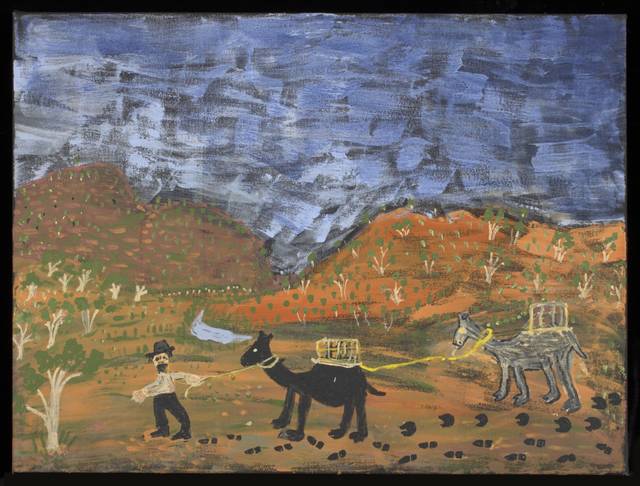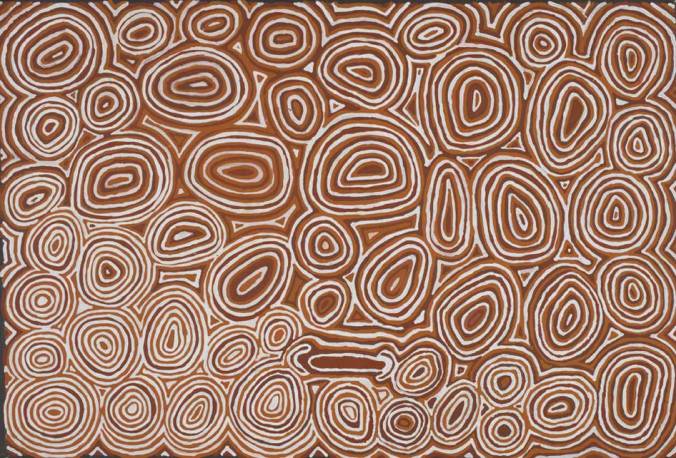This last winter I was lucky enough to have the chance to spend more than a month in New South Wales, Australia. All around the cities in New South Wales I saw many pieces of art that I found absolutely fascinating. All of these paintings seemed so simple, but the more I learned about them I realized there was a lot of history in these paintings. The Style I became most interested in was the Western Desert Art, how it is evolving, the many emerging styles of it, and its many collections. This art movement emerged from the Aboriginal settlement of Papunya in the Northern Territory of Australia in the early 1970s. In 1971 the art teacher posted in the village Geoffrey Bardon encouraged some of his traditional artists to paint a blank wall. This painting, influenced many of the people of the community to start painting. From the painting on the blank wall emerged the style and artists of the Western Desert Art Movement. This art style represents the interior of Western Australia, South Australia, and some of the Northern Territory. Many of these artists often use symbols as their style to tell their stories in their artwork. Today this style is still evolving and influencing many artists and is recognized around the world with many of the pieces being kept at the National Museum of Australia.
Warakurna is a style of art that started in 2005 and is emerging from the Western Desert Art Movement. This style of art has a storytelling element to it. These pieces often include the history of life in the Aboriginal communities. One of the evolving artists is Eunice Yunurupa Porter.

Lasseter Story was painted in the Warakurna Community, Western Australia by Eunice Yunurupa Porter in 2011. This painting depicts the story of explorer Harold Bell Lasseter as he traveled in search of gold. There is legend that Lasseter discovered gold in Warakurna, in what is referred to as ‘Lasseter’s Reef’ but the reef has never been found. Legend has it that Lasseter walked with camels as his only company all over Western Australia in search of gold. He frightened many of the people of the villages as he traveled through them because they had never seen a white man before. Many of the men of the villages followed him while the children ran into the arms of their mothers because they were scared. He was often called Mamu or devil man.
I selected this picture because of the story. I remember reading the story and looking up at the picture and thinking that it was just fascinating. This was my favorite painting that I found of the story of Harold Lasseter. This painting I think does a really good job of showing that part of Australia and the history behind it.
What I enjoy about the actual painting is the color, the space, and the lines. I think the colors of painting do a great job of capturing what the landscape in Australia looks like. As I enjoy the colors of the painting I can think back to what it actually looks like there. I think the artist does a great job of creating space in this painting. The hills in the background have such a rolling effect to them it is almost mesmerizing. The lines in this painting are so simple but form such an eloquent picture that is what I love about this art. The detail I really enjoy the most about this picture is the sky. I remember walking around at night and thinking how beautiful sky was and looking at this painting it makes me miss the nights in Australia. I think this a really great painting overall and I have a very positive reaction towards it. I would really enjoy this painting in my house.
Of the many collections of the Western Desert Art Moment is the Canning Stock Route collection. This collection tells the story of the route’s impact on the Aboriginal people. These stories tell of exodus and return and conflict and survival all seen through Aboriginal eyes. They have been passed down through the generations and are now being expressed through the new movement of art. One of the emerging artists is Norma Giles. Giles grew up in the bush of Patjarr which is off of one the trails of the Canning Stock Route.
The Canning Stock Route runs from Halls Creek in north Western Australia to Wiluna in south Western Australia. A stock route is used by farmers to get their cattle from one place to another. This route is in the deserts of Western Australia and is one of the toughest and remote tracks found in the world. The building of this route impacted many of the Aboriginal people who lived where it was being constructed.

Kapitu Kapitu was painted in 2008 by Norma Giles in the Patjarr Community. Kapitu Kapitu means “water to water”. This painting depicts the journeys of Norma’s ancestors to watering holes all along the Canning Stock Route. All the circles in the painting represent the watering holes and if you look closely towards the bottom center, there are two U-shapes. These U-shapes represent two men traveling along the stock route in search of watering holes and the shape between the two U’s is there wiltja or bush shelter.
What made me select this painting was the two U-shapes in the bottom center of the painting. I remember looking at the painting and thinking they look so out of place. But, I came to find out they are what make this painting so important. I found it fascinating how two little symbols could tell such and amazing story as the one in this painting.
In this painting, I really like her use of lines, color, and shape. Her use of lines is so simple in this painting, but they tell such a fascinating story. I found the colors of this painting very relaxing to look at it. If I look at it too long they almost put me in a trance. I think the shapes in the painting are very interesting. I would like to ask her why she chose the shapes that she did for this painting. I really like this painting and the story and history in it is amazing. I think this painting would look very nice in a restaurant.
Papunya is a remote settlement in the Northern Territory of Australia it is often referred to the birthplace of contemporary Aboriginal art, the Western Desert Movement. Papunya is the genesis of the Western Art movement and is related with the style of ‘back to country’. The Early style of Papunya paintings are called Tjukurrpa or dreaming paintings. These paintings often depict the acts of ancestral beings that wandered the landscape of the Western Desert. One of the leading artists of this genesis was Uta Uta Tjangala.

In 1974 Uta Uta Tjangala painted Ngurrapalangu in the settlement of Papunya. This painting depicts an encounter between the ancestral being known as Short Legs, two women who are traveling, and the ancestral being known as Old Man. This encounter took place on the sacred site of Ngurrapalangu. Upon seeing the Old Man, the women fled towards Wilkinkarra, while the women were fleeing, Short Legs hid inside a cave. Upone getting inside the cave on the sacred spot he began throwing around the sacred objects. The sacred objects that Short Legs threw became a hill south of the claypans.
What made me select this painting was just simply how fascinating it looked. I had no idea of the story that it was telling when I found this picture. Out of all this pictures I saw I thought this one was the most fascinating and would be perfect for this blog. The detail I really enjoy is the wavy lines in this painting.
The elements I really enjoy about this painting are the lines, color, and texture. I really enjoy how wavy and simple the lines are in this painting. He uses something so simple to make an amazing painting. I love the combination of colors in this painting. They all flow together and really make this painting stand out. With the texture of this painting I feel like I could stick my hand out and feel all the wavy lines. I think this painting would look good in a hotel lobby.
As we have learned throughout this summer many of the artists of the different eras in America and Europe relied on history and mythology as the subjects of their art work. But, one of the major cultural differences between Aboriginal art and American and European art is that the Aboriginals are telling the stories of their ancestors, stories that have been passed down through the ages. Another major cultural difference is the style. We have learned about so many different styles this summer. The Aboriginal’s keep it simple. They use lines, dots, circles, squares, or other simple objects to portray their stories in their artwork. In comparison to American and European art, Aboriginal art often serves a purpose mostly spiritual or ceremonial. Overall the Aboriginal’s represent a culture that is not American or European, they represent a culture of their own.
I found it the style very fascinating the more research I did on the Aboriginal art. The more and more I studied it the more my appreciation for the art and the artists grew. I am really glad I get to share such a great art movement on my blog. I hope you guys enjoyed it as much as I did!
Works Citied
“Australian Museum.” Western Desert Art – Australian Museum. N.p., n.d. Web. 23 July 2017.
<https://australianmuseum.net.au/collection-stories-western-desert-art>.
https://australianmuseum.net.au/collection-stories-western-desert-art
“Lasseter Story by Eunice Yunurupa Porter.” National Museum of Australia. N.p., n.d. Web. 23
July 2017. <http://collectionsearch.nma.gov.au/object/213000>.
http://collectionsearch.nma.gov.au/object/213000
“Ngumarnu Norma Giles.” Canning Stock Route Project. N.p., n.d. Web. 23 July 2017.
<http://www.canningstockrouteproject.com/artists-and-artworks/ngumarnu-norma-giles/>.
http://www.canningstockrouteproject.com/artists-and-artworks/ngumarnu-norma-giles/
“Papunya collection.” Papunya collection | National Museum of Australia. N.p., n.d. Web. 23
July 2017. <http://www.nma.gov.au/collections/highlights/papunya-collection>.
http://www.nma.gov.au/collections/highlights/papunya-collection
“Uta Uta Tjangala.” Uta Uta Tjangala | National Museum of Australia. N.p., n.d. Web. 23 July
2017.<http://www.nma.gov.au/exhibitions/papunya_painting_out_of_the_australian_desert/uta_uta_tjan gala>.
http://www.nma.gov.au/exhibitions/papunya_painting_out_of_the_australian_desert/uta_uta_tjangala
“Western Desert art.” Western Desert art | National Museum of Australia. N.p., n.d. Web. 23
July 2017. <http://www.nma.gov.au/exhibitions/warakurna/western_desert_art>.
http://www.nma.gov.au/exhibitions/warakurna/western_desert_art